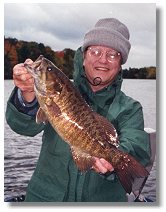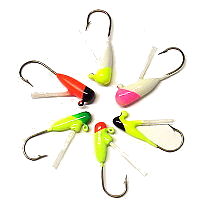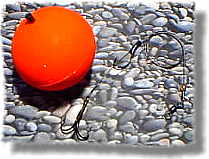Fall Smallmouth Bass & Northern Pike: A well kept secret!
Fall Smallmouth Bass & Northern Pike: A well kept secret!
By Mike Mladenik
 Last year was an exception in some areas you could launch your boat as late as December. In a normal year in northern Wisconsin we see hard water by the second or third week of the month. North winds and occasional snowstorms can question your sanity especially on the slow days. Unfortunately, the slow days will outnumber the productive ones. Despite the wretched weather many anglers including myself continue to fish what open water. Putting it all into perspective it takes a special breed to persevere during this late season.
Last year was an exception in some areas you could launch your boat as late as December. In a normal year in northern Wisconsin we see hard water by the second or third week of the month. North winds and occasional snowstorms can question your sanity especially on the slow days. Unfortunately, the slow days will outnumber the productive ones. Despite the wretched weather many anglers including myself continue to fish what open water. Putting it all into perspective it takes a special breed to persevere during this late season.
When it comes to late season fishing most people think of musky or walleye. Few people in the Midwest pursue smallmouth bass before ice up. For those looking for a trophy smallmouth only the pre-spawn period produces more big fish. After spawning large smallmouth scatter and are tough to locate in most natural lakes.
Choosing the proper lake is important. Clear water lakes with limited structure and a restricted forage base are the key. Many deep clear water lakes are home to giant smallmouth. However, in summer and early fall, large fish are difficult to locate let alone catch them. By late October and early November food is limited and large smallmouth will school up. Once you locate the primary forage base on the lake smallmouth won't be far behind. Finding spawning ciscoes is the key to smallmouth location. Besides having a population of big smallmouth it should be a lake void of muskies. Muskies will dominate the food chain and smallmouth movements will be unpredictable.
Don't make the mistake of only fishing big lakes. Small clear water lakes can hold a population of large smallmouth. Each year I boat a number of 20 inch plus smallmouth from a lake only 125-acres. Again it is important to find a lake with a limited fishery. If a healthy smallmouth population exists, smallmouth can be the dominant predator in the lake. Lakes with few if any walleyes are the best. These smaller lakes are easier to fish with smallmouth schooling up and holding in one or two areas of the lake.
Forage is very limited on smaller lakes. In late fall these baitfish populations are dwindled, and food is limited. Once you hone in on the forage, you should find smallmouth. Use your electronics to spot schools of baitfish. These areas will be any offshore structure, shoreline points and steep shorelines. With cover limited, you can find schools of big smallmouth stacking up over this cover. This was a similar situation that I mentioned earlier.
Large shiners and chubs are both effective. If shiners are dominant in the lake use them. If chubs are present in the lake they should be the bait of choice. I have had only limited success with suckers. However, if live bait is hard to obtain, use what you can get. Mark a school of smallmouth and vertical jig with a jig and minnow combo. It is important to use the lightest jig possible, so you can feel the slightest pick up.
 Slo fall jigs are deadly during the late open water period. If fishing heavy cover use an ISG slow hall jigs. Bait Rigs Slo-Poke jigs and Slo-Up jigs are also perfect for cold water smallmouth. If the bite is light use a plain Aberdeen hook with just enough weight to get the minnow to the bottom. For the artificial bait purist jigging spoons and plastics will take these late season smallmouth. ISG skirted grubs, tubes and four-inch worms are an excellent choice if you prefer to fish with plastics. When fishing in cold weather a quality rod is essential. A Lamiglas GS 66LL Spinning rod will allow you to fish both artificials and live bait. Look for the best smallmouth action to occur during the mid day period especially after a few days of stable weather.
Slo fall jigs are deadly during the late open water period. If fishing heavy cover use an ISG slow hall jigs. Bait Rigs Slo-Poke jigs and Slo-Up jigs are also perfect for cold water smallmouth. If the bite is light use a plain Aberdeen hook with just enough weight to get the minnow to the bottom. For the artificial bait purist jigging spoons and plastics will take these late season smallmouth. ISG skirted grubs, tubes and four-inch worms are an excellent choice if you prefer to fish with plastics. When fishing in cold weather a quality rod is essential. A Lamiglas GS 66LL Spinning rod will allow you to fish both artificials and live bait. Look for the best smallmouth action to occur during the mid day period especially after a few days of stable weather.
Northern Pike
Another untapped late season resource is northern pike. Few people realize the potential for trophy pike where muskies get all the attention. Although trophy pike lakes are few when compared to top-notch musky lakes, they are far from rare. Most trophy pike lakes have few if any muskies present. Like trophy musky lakes, deep clear lakes produce the largest muskies. These lakes usually have a limited pike population. Lakes that are know for producing numbers of pike seldom hold trophy pike.
 Most trophy pike lakes in northern Wisconsin are less than 1,000 acres. While some larger lakes do have a few trophy pike, they usually contain musky fisheries. Some will have offshore humps and shoreline points, while others will have no viable structure. Those that have structure will be easier to fish. On lakes were musky are absent, pike will become the dominant predator within the lake. Unlike big muskies, large pike cooperate well. Once they are marked with your electronics, you have a good chance of catching them. Quick strike sucker rigs are also effective for these deep feeding pike. However, since we are looking for 20 pound plus fish as opposed to 40 pound plus fish, use a smaller sucker. I prefer to use suckers in the 12-inch range when hunting for late season trophy pike.
Most trophy pike lakes in northern Wisconsin are less than 1,000 acres. While some larger lakes do have a few trophy pike, they usually contain musky fisheries. Some will have offshore humps and shoreline points, while others will have no viable structure. Those that have structure will be easier to fish. On lakes were musky are absent, pike will become the dominant predator within the lake. Unlike big muskies, large pike cooperate well. Once they are marked with your electronics, you have a good chance of catching them. Quick strike sucker rigs are also effective for these deep feeding pike. However, since we are looking for 20 pound plus fish as opposed to 40 pound plus fish, use a smaller sucker. I prefer to use suckers in the 12-inch range when hunting for late season trophy pike.
November fishing is not for everyone, but it is prime for catching trophy fish. However, if you prepare yourself mentally and physically you can be successful. You can prepare yourself by dressing properly but putting yourself in the right frame of mind during a snowstorm can be a bit tough.
For more information, visit mike at his website at www.mikemladenik.com
|
